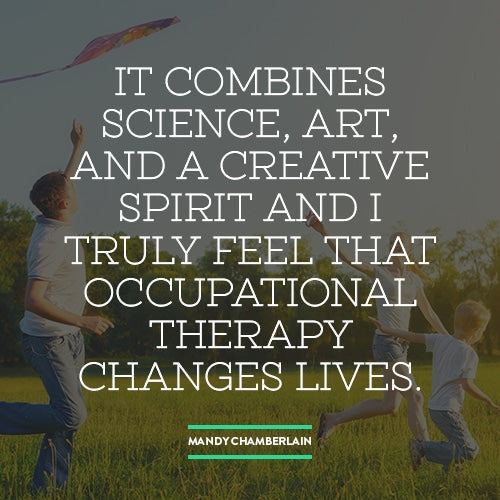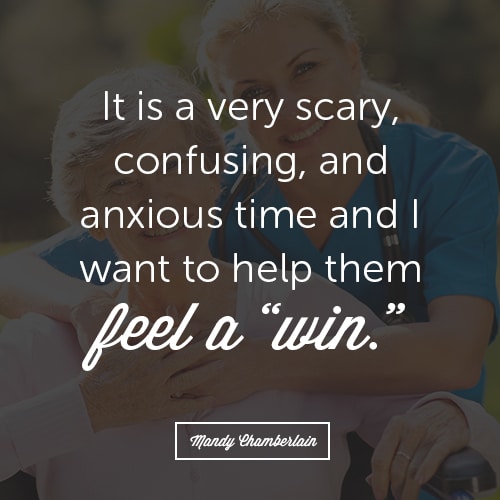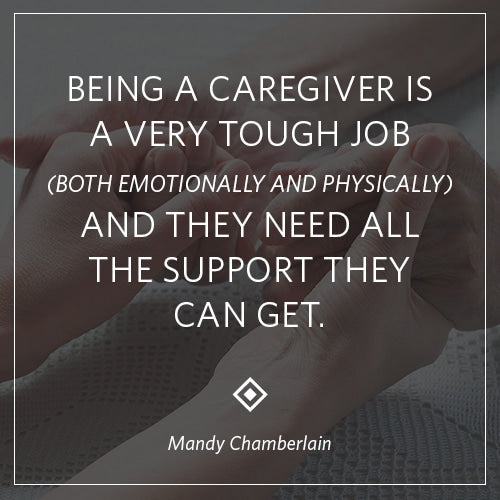Stroke Recovery Advice With Occupational Therapist Mandy Chamberlain

We had a chance to connect with Occupational Therapist Mandy Chamberlain to get her helpful and inspiring stroke recovery advice and patient stories.

Stroke Recovery Advice With Mandy Chamberlain
seniorsflourish.comBeginning a Career in Occupational Therapy
How did you get your start as an OT? I was first exposed to Occupational Therapy after my “Gramps” had a stroke. When I was a teenager, he lived on my family’s property and we helped take care of him with cooking, cleaning, driving and medication management instead of him going into assisted living. He had a massive CVA while living with us and had to go into a nursing home, as he was flaccid on his left side and we couldn’t physically care for him any longer. He had occupational therapy, physical therapy, and speech therapy while in the nursing home and I attended sessions with him while he was in rehab. I had never been exposed to OT before, but I was able to see the variety of patients they were working with and the progress they were making. It excited me. Why did you choose OT? In addition to having the first-hand experience of my Gramps working with Occupational Therapy, I loved the real-life impact that OT has on the day-to-day tasks that are important to people. It combines science, art, and a creative spirit and I truly feel that OT changes lives.

On Occupational Therapy
What is the #1 trait you find in great Occupational Therapists? Being a good listener. If you can listen to understand, not listen to answer, you can find out exactly what the patient needs and you can work together as a team to accomplish THEIR goals. When are Occupational Therapists typically brought into the stroke recovery process? Occupational therapists start working with people who have had a stroke the very first day. There tends to be a certain amount of spontaneous recovery within the first few days and weeks after a stroke, but we want to get them moving right away. What is surprising to learn for new OTs as treat their first stroke patients? Even though I had learned that “every stroke is different,” I was amazed how true it really was. Also, I found it surprising how heavy a flaccid arm is to work with. You will definitely get your sweat on!
On Stroke Recovery
Where do you focus your efforts first when treating a new stroke patient? My first focus is safety, early functional mobility, and basic ADL, such as working on washing their face or feeding. I like to work on very short term goals. It is a very scary, confusing, and anxious time and I want to help them feel a “win.” I also start educating the patient and family right away on what to expect after a stroke and the rehabilitation process.

Advice For Caregivers
What are your top tips for new caregivers? I always recommend family and friends being educated on the type of stroke that their loved one has experienced. This will help them understand their physical limitations and how their cognition has changed. With this information and the help of their OT/PT/SLP, they will be able to better understand what they need to do in order to help with the recovery process. Examples would be how to help with a flaccid arm or how to handle verbal outbursts due to cognitive changes. Another to tip is for friends and family to remember this is a long recovery process. After a stroke, there is always a lot of support from the community, family and friends, but as time goes on, that support dwindles. It is a good reminder that support is needed at all stages of recovery, from bringing meals to a caregiver that is tired and doesn"e;t want to cook, to providing respite care for a few hours so the caregiver can get their own TLC, or even socialization with the person who has had the stroke, as it can be a lonely and life changing event. What are your best “hacks” for helping caregivers increase your client"e;s participation in daily activities? Use the recommendations from their occupational therapist on finding out what their abilities are to complete daily activities. Do they need adaptive equipment? Do they need one step directions or posted instructions on the wall? Do they need to use alarms or reminders? Do they just need extra time? How can caregivers best assist OTs? How can OTs best assist caregivers? If caregivers can give an honest description of the patient’s day - their routines, what has been difficult or easy, medications and reactions, what is working and what isn’t, etc - it can help the OT to make personalized, collaborative goals and focus towards working on what is important to them. OT’s can help educate, inform, and provide resources to caregivers to help them succeed. Being a caregiver is a VERY tough job (both emotionally and physically) and they need all the support they can get.

An Inspirational Stroke Recovery Story
I have worked with many people over the years, but one of my favorite recovery stories is about a patient whose goal was to get back to volunteering for his favorite MLB team. He and his wife helped assist fans find their seats at the stadium and pass out brochures. They were HUGE fans and it was a way for them to socialize, meet new people, and go to all the games for free. They loved it and they had done it for years, but in order to go back to volunteering, he needed to be able to go up and down (many!) stairs, do a lot of visual scanning, and use both of his hands to pass out the brochures. It was such a collaborative effort between OT, PT, and the patient. We simulated the task and was able to break it down and figure out the exact areas that he needed to focus on in order to be able to do it again. He was such a hard worker and was able to fulfill his dream of returning to his volunteer position. It was so fulfilling and fun! I now see him at the grocery store from time to time and he always waves proudly with his left hand.
Whether you are a caregiver, occupational therapist or a even a stroke survivor yourself, Saebo provides stroke survivors access to transformative and life changing products. We pride ourselves on providing affordable, easily accessible, and cutting-edge solutions to people suffering from impaired mobility and function. We have several products to help with the stroke recovery and rehabilitation process. From the SaeboFlex which allows clients to incorporate their hand functionally in therapy or at home, to the SaeboMAS, an unweighting device used to assist the arm during daily living tasks and exercise training, we are commitment to helping create innovative products for stroke recovery. Check out all of our product offerings.
All content provided on this blog is for informational purposes only and is not intended to be a substitute for professional medical advice, diagnosis, or treatment. Always seek the advice of your physician or other qualified health providers with any questions you may have regarding a medical condition. If you think you may have a medical emergency, call your doctor or 911 immediately. Reliance on any information provided by the Saebo website is solely at your own risk.



